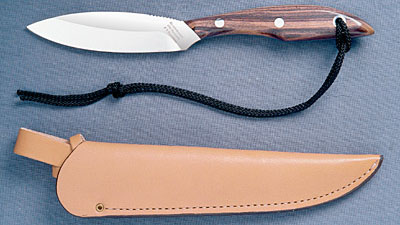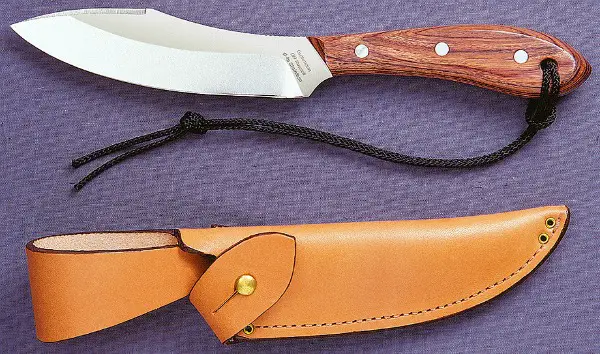|
Grohmann Outdoor Knives By Gary Zinn  Have you heard the story of the Czechoslovakian refugee who teamed with a Canadian Prime Minister's private secretary to design an iconic outdoor knife? The Czech was Rudolph Grohmann, his Canadian partner was Deane H. Russell and the knife was the Grohmann #1 D.H. Russell Canadian Belt Knife, also known as the "Original Canadian Belt Knife." The somewhat convoluted story of how Rudolph Grohmann and his family immigrated to Nova Scotia after World War II and how he teamed with D.H. Russell to design their famous knife (along with three others) is summarized on the Grohmann Knives website (www.grohmannknives.com). Suffice it to say here that the first knife designed by Grohmann and Russell was and remains the flagship of the family of outdoor knives made by the Grohmann Knives firm.Guns and Shooting Online contributor Cal Bablitz has written an excellent review of the Grohmann #1 Knife. Overview of Grohmann knives The bulk of the Grohmann outdoor knife lineup consists of fixed blade hunting knives. There are a dozen models or variants, ranging in size from the #104F Mini Skinner, with a 2-1/2 inch blade, to three knives with 5-1/2 inch blades. There are two sizes of lock back folders with blade and handle profiles following that of the Grohmann #1 fixed blade design, joined by three drop point lock-back and two slip joint pocket knives. Grohmann also makes fillet knives in four blade sizes, five through eight inches. Finally, the firm makes several types and sizes of kitchen knives. Besides the original #1 model, R. Grohmann and D.H. Russell designed three other knives together. These are the #2 Trout & Bird, #3 Boat, and #4 Survival models. The #2 knife is a scaled down version of the #1, while the #3 has the elliptical blade profile of the #1, but a differently shaped handle. The #4 is different from the three preceding designs in both blade and handle profiles. All but a couple of the standard models of Grohmann fixed blade hunting knives have certain features in common. These include full tangs, "regular" (sabre) ground stainless steel blades and rosewood handle scales. All models come with leather belt sheaths. Steel, grind, and sheath options Most models can be ordered with either stainless steel or carbon steel blades. The steels used are European 4110 high carbon stainless (similar to USA 440 series stainless) and C70 type European carbon steel. Tempering of either is to Rc 56-58. Grohmann claims that these steels have a good balance of edge holding ability and ease of resharpening. I owned a #1 model stainless steel knife for a time. I gave it to a nephew who could not keep his eyes and hands off of it, but not before I used it enough to learn that it did take and hold a good edge. My judgment is that it performed much like 420HC and 440C. I have no experience with C70 steel, so cannot evaluate it either on its own merits or relative to proven carbon blade steels. It is rumored to be very similar to 1070 or 1075 plain carbon steel. This is true in the sense that the recipe for C70 includes amounts of carbon and manganese in the same range as 1070 and 1075. However, C70 also contains small amounts (0.25 percent or less by weight) of chromium, molybdenum and silicon; these are not part of the recipes for plain carbon steels like 1070 and 1075. These elements all strengthen alloy steels in which they are used, which implies that C70 would have somewhat more tensile strength and wear resistance than 1070 and 1075. Whether C70 is as good as proven non-stainless knife steels (e.g. 1095, D2) I cannot judge. I have shared what I learned about C70, for whatever it may be worth to anyone trying to decide between the two steel options available in Grohmann knives. One may get most models with either regular (sabre) ground or flat ground blades. The regular grind removes less of the nominal blade thickness, yielding a stronger blade relative to the flat grind, which continuously thins the blade from spine to cutting edge. Thus, a regular grind blade would be better for heavy work, while flat ground blades result in a lighter knife that is better for slicing and fine work. Finally, particular models of hunting knives may be ordered with up to four types of premium handle material, in lieu of the standard rosewood. Models may have up to three sheath design options beyond the standard sheath. The company website provides details on what steel, blade grind, handle and sheath options are available for specific models. Some of these are by custom order only and come at additional cost. Warranty and repairs Grohmann backs their products with a Lifetime Limited Warranty and they offer professional sharpening services, for any brand knife. They can sharpen both plain and serrated edges. They will even repair and recondition damaged or neglected knives, whenever feasible. The #4 Survival Knife  With a 5-1/2 inch blade, the #4 shares honors of being the largest Grohmann hunting knife, along with the #4 Survival with Guthook and the #108 Deer and Moose knife. The blade of this knife is 1-3/8 inches wide, 3/16 inch thick and the knife is 10-5/16 inches long overall. For comparison, the #1 knife has a 4x1x1/8 inch blade and is 8-1/2 inches long overall. I could not find a weight specification for the #4 knife, but I would guess it to be about six ounces, with the sheath adding perhaps two ounces to the carry weight. The #4 blade shape most closely resembles a "Nessmuk" style knife. Nessmuk was the pen name of George Washington Sears, a 19th Century adventurer and conservationist who wrote extensively of his experiences in the Adirondack Mountains of New York State. His favorite, all purpose woods knife had a wide blade with an upswept spine, continuously curved cutting edge and pronounced drop from the spine peak to the point. Thus, knives with similar blade profiles are called Nessmuks. The image above shows the standard configuration of the #4 Survival knife, with regular ground stainless steel blade, rosewood handle scales and button tab leather sheath. The 2017 MSRP is $137 (Canadian) and the U.S. retail price is about $100. The knife may be ordered with a carbon steel blade and either type of steel can be ordered sabre or flat ground. Alternative handle scales include Xtra Resinwood, Black Linen Micarta, Water Buffalo Horn, or Stag Horn. Sheath alternatives include open (pouch), or overlap (army) types, or a sheath with a sharpening steel in its own pouch. The #4 Survival would serve well as a heavy duty backcountry pack knife, for field dressing and butchering large animals and as an all-around camp knife. It would be on my short list of knives suitable for any of these purposes. If I were to order one from the factory, I would specify the stainless steel blade with regular grind, linen micarta handle and overlap sheath. This would be a versatile and durable heavy duty knife and sheath package. Conclusion With new knife brands or models steadily being introduced with much marketing and media hype, it is easy to overlook some of the oldies, but goodies. Grohmann outdoor knives fall into the latter category. One of their well designed and use proven knife models might be the "just right" knife you are looking for, whether for general outdoor use or a special purpose. |